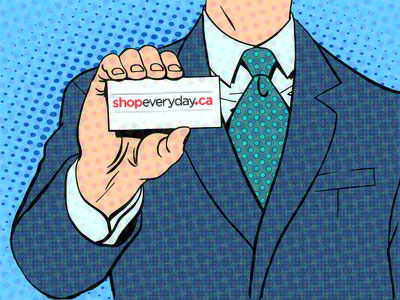
B2B OFFICE & PROMOTIONAL SOLUTIONS
- 1.833.3WE.ROCK
- info@shopeveryday.ca
- Blog

B2B OFFICE & PROMOTIONAL SOLUTIONS
Although technology seems to have taken over nearly every aspect of the business world, there is still one thing essential to professionals that cannot be digital: business cards. Professionals of every industry know that good networking is achieved by having a business card to put right into a person’s hand. Whether you’re a startup company, self-employed or work for a major corporation, a business card is not just a reminder of a conversation, but it is an extension of you as a professional and a tangible piece of your company. In short, business cards carry reputation.
Here’s a quick breakdown on must-have components of a business card:
Remember your teacher telling you that if your paper didn’t have your name on it, then she wouldn’t know who the paper belonged to and would be discarded? A business card without your name on it gets treated the same way—they won’t call your business for its services let alone get you the commission.
Make sure your name is easily ligible by selecting an appropriate font and colour that has contrast to the background. Black and white is classic, but try opting for brighter colours to get your card to stand out. The idea is not to make your card gaudy, but to give it a personality that matches your own, another nudge that says “remember me.”
Also, be sure to include the title of your position for better context. Most of the time, your business card is distributed because you’ve met someone new. In this case, your name and title are your best identifiers. You don’t want someone to call up, ask for John Smith and be met with the response, “Which John Smith did you speak with? We have two in Sales and one on the Marketing Team.” Your lead will likely reply, “Uhh…I’m not sure…”
A business card is your ambassador after the conversation ends and both parties go their separate ways. Make sure that it fully represents you.
Remain consistent with your brand when developing your business cards. If you give someone your business card, and they happen to navigate back to your website for more information, you want to create that seamless connection. The best way to get this seamless branding is to make sure you have your company’s logo or branded name on your card. Some companies distribute the same business cards with the same colours for all employees and personnel. However, newer businesses often steer away from this, making room for personalization that makes a more memorable, creative card. The key here is balance.

Make sure your contact information is easy to read on your business card. Keep it simple! Remember to include a personal work email and phone number with your extension, if applicable. This further boosts your credibility, shows that you’re available for future discussion, and gives a person an easy way to get
in contact with you directly instead of going through a receptionist. If you prefer to be contacted via social media, indicate this on your business card as well.
Once you’ve added all the necessary elements to your business card, make sure there is still sufficient negative space (or white space). ‘Negative space’ simply refers to an area of the business card that does not have text or imagery. This is important to allow readers to easily skim the card—remember, this is a business card, not a resume. Your card will look more professional if it isn’t cluttered with too much information. If you find that there isn’t enough white space, you might consider decreasing your font or logo size, or completely removing some information. If appropriate, you can also think about using both side of your business card. However, many companies prefer to use the back of a business card to make a it more memorable…
There are a number of creative tactics you can use to make your business card stand out. This is especially important because of the sheer number of cards being printed and exchanged on a daily basis. As we mentioned above, the back of your business card is the perfect place to make it unique or personalized to you. Add colour, logos, or even images. For example, a photographer may choose one of his favourite shots as a representation of his work on the back, while an architect may prefer to have a snippet of her blueprint rendering. Plus, don’t count out the card’s material. Business cards can have satin or shiny finish, and can range in durability. How the card feels in someone’s hand is a way to uniquely engage the sense of touch to make a good impression as well.
Ready to make your super impressive business card?
Trust the Everyday Office’s printing services to work with you to make a sleek, memorable, great business card.
After reading this free 12-page guide, you'll know the right questions to ask when it comes to pricing, order and delivery process, product support, invoicing & payment terms, and more.
Copyright © 2024 ECI Software Solutions, Inc. All rights reserved.
Images and content are owned or licensed by Everyday Office Supplies Inc.